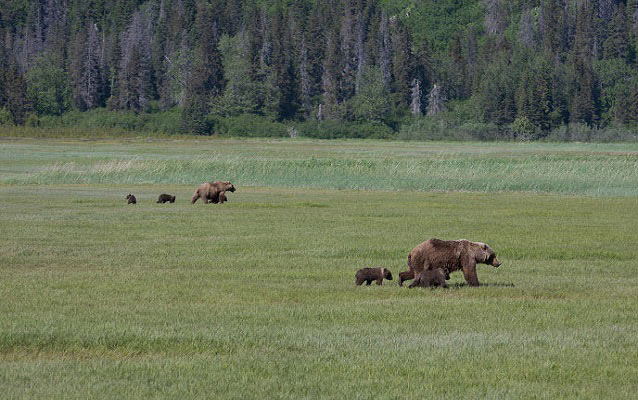Last updated: April 23, 2019
Lesson Plan
Carrying Capacity and Bears in Alaska

- Grade Level:
- High School: Ninth Grade through Twelfth Grade
- Subject:
- Literacy and Language Arts,Math,Science,Social Studies
- Lesson Duration:
- 90 Minutes
- Additional Standards:
- CCSS.9-10.RST.2. CCSS.9-10.WHST.9
NGSS: HS-LS2-A. HS-LS2-1.
Essential Question
What is carrying capacity?
Objective
Students will identify factors affecting carrying capacity.
Students will explain why some animals are successful while others are not.
Background
Lake Clark National Park and Preserve sits on the coast of the Cook Inlet and is home to one of the largest brown bear populations in the state of Alaska.
Park biologists work year-round to study the brown bears that live in Lake Clark. They observe the bears' diet, competition (both for mating and preferential habitat), and longevity. With rich vegetation, a large supply of bivalves, and spawning salmon, Lake Clark offers plenty of food for bears to thrive. This contrasts drastically with the interior of the state, where food is scarcer and bear populations are comparatively low.
Data gathered by park biologists gives an inside-look at the lives of bears, providing us with the opportunity to explore the idea of carrying capacity (i.e., how many animals can live in a given area).
Preparation
Carrying Capacity Activity Guide
Materials
Procedure
1. Have students read the "Lesson Overview" and "Activity One: Reading" in the Student Activity Guide.
2. Give the students the Response Sheet and have them answer the questions based on their readings. Students can answer all the questions themselves, or they can be broken into small groups of 2 or 3 to discuss specific questions and then present what they discussed to the rest of the class.
1. First, have students watch “A Day on the Lake Clark National Park Coastline".
2. Have students look at the Lake Clark Bear Research map and the data table provided in the Student materials packet. From the table, they will create a graph that shows a comparison of bears in different areas of the park. What trends, if any, do they see?
Give students the Student Assessment (found in the Student Activity Guide). They can work individually or in groups of two or three.
Online, students should research the ecosystems of two Alaska parks - Denali, which is in interior Alaska, and Lake Clark, which is in coastal Alaska. In researching Lake Clark, students should focus on Chinitna Bay and Silver Salmon Creek. Students should also review the film "Over the Mountains."
In their research, students should explore the habitat of these two unique areas, focusing on the types of plants and animals that might be a part of the bear’s diet. They should look up information on tundra, taiga, estuaries, and salt marshes (in Lake Clark).
Recommend to students that they look at population data on moose, caribou, salmon, bivalves, and other plants and animals. This type of information could be a limiting factor for bear populations in each areas. Remind students to consider the ease of gathering food resources as a given resource is evaluated (e.g., digging up clams and other bivalves is much easier than hunting moose).
Allow students 1-3 class periods to gather resources, create their diagrams, and construct their responses. If there is time, allow the students to present their projects to the class, or offer time for discussion and evaluation of the concepts they learned.
Vocabulary
wildlife biology, carrying capacity, Limiting Factors, biology, plants, animals, lacl, alaska
Assessment Materials
- Students will create a Venn-diagram displaying the similarities and differences between the diets of inland and coastal bears.
- Students should write a statement regarding carrying capacity, in which they correlate bear populations in different ecosystems.
